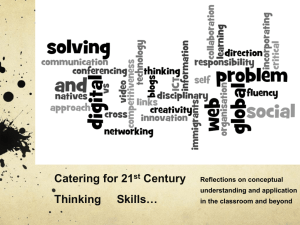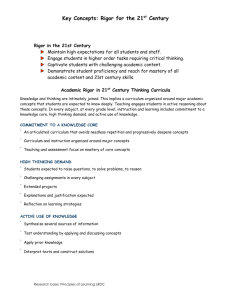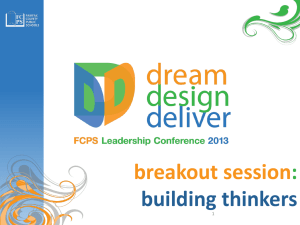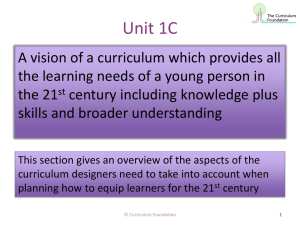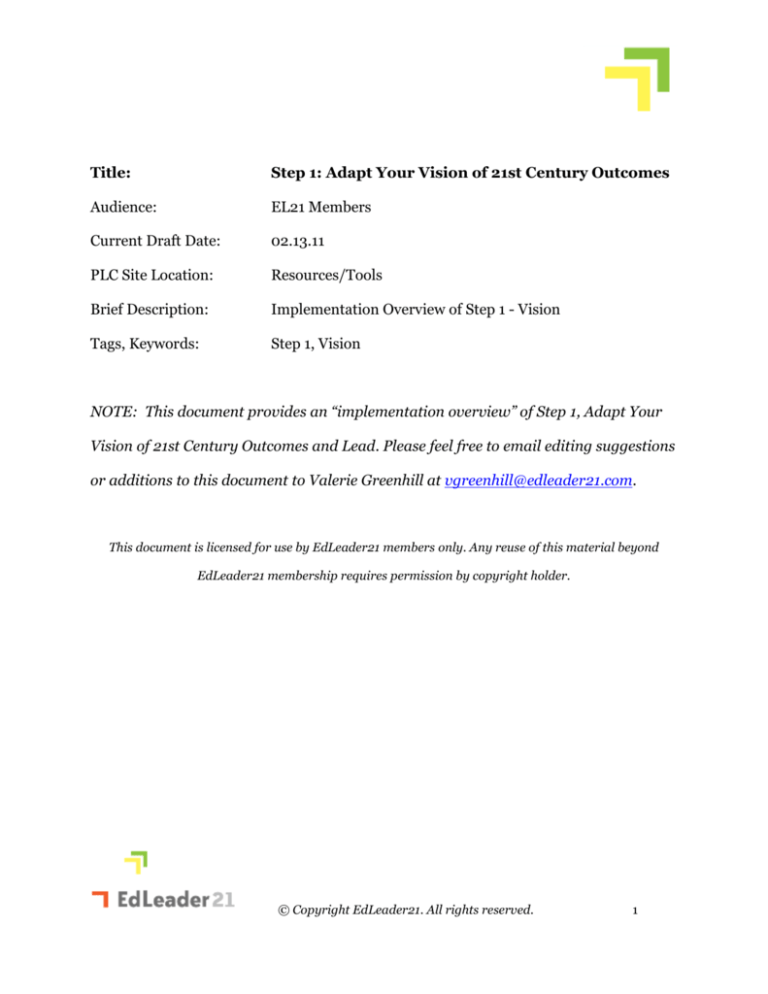
Title:
Step 1: Adapt Your Vision of 21st Century Outcomes
Audience:
EL21 Members
Current Draft Date:
02.13.11
PLC Site Location:
Resources/Tools
Brief Description:
Implementation Overview of Step 1 - Vision
Tags, Keywords:
Step 1, Vision
NOTE: This document provides an “implementation overview” of Step 1, Adapt Your
Vision of 21st Century Outcomes and Lead. Please feel free to email editing suggestions
or additions to this document to Valerie Greenhill at vgreenhill@edleader21.com.
This document is licensed for use by EdLeader21 members only. Any reuse of this material beyond
EdLeader21 membership requires permission by copyright holder.
© Copyright EdLeader21. All rights reserved.
1
Introduction: The Importance of a Personal Vision
Every stage in this journey rests on the foundation that is your personal vision for
21st century education. A deep, well-thought-out conviction about your vision serves as
the most important anchor for you, your school, and/or your district in this journey.
Step 1, Adapt Your Vision of 21st Century Outcomes and LEAD, will help you define
your vision of a 21st century student, and the education she needs to get there.
We believe your vision for 21st century education will be more thoughtfully
constructed if you consider the following reflections and what they mean to you.
Reflection: The Workforce
Workforce skills and demands have changed dramatically in the last twenty
years. Our system of education was built for an economy that no longer exists. Your
vision for education will inevitably draw upon the issue of workforce and career
preparedness in the digital economy.
Levy and Murnane, noted economists who focus on the workforce, have done
groundbreaking research that shows where the job declines and inclines of the last 4050 years have been.
© Copyright EdLeader21. All rights reserved.
2
The chart shows that there have been steadily declines in “routine” work. Why are
“routine” jobs in steady decline? The more something is routine, the easier it is to
digitize it. Once the work can be digitized, the work can be automated or it can be offshored.
On the other hand, jobs that involve non-routine analytic and interactive
communication skills are increasing rapidly. These are jobs that require critical thinking
and interaction with people—things that are not easily replicable. Jobs that focus on the
special needs of students, patients, clients, and customers are not likely to be digitized,
© Copyright EdLeader21. All rights reserved.
3
automated or off-shored. The perspectives of labor economists like Levy and Murnane
provide a useful backdrop for thinking about our current model of education and
whether it is adequately aligned with the needs of the modern economy.
A notable P21 (Partnership for 21st Century Skills) publication “Are They Ready to
Work?” definitively gives voice to how concerned corporate human resource managers
have become about the knowledge and skills of recent graduates. When employers were
asked to rank the content and skills were most valuable among high school graduate
hires, the response was illuminating. These executives overwhelmingly prioritized the
following skills: work ethic, collaboration, good communication, social responsibility,
critical thinking and problem solving. These were also the very same skills these
employers found lacking among recent hires of high school and college graduates.
The data about the workforce as noted by Levy and Murnane and P21’s work of
the last eight years is all incredibly important. But this work never received the nation’s
full attention until Thomas Friedman’s groundbreaking book The World is Flat was
published in 2005. It re-contextualized the SCANS skills and other workforce models in
the context of the emerging global economy. While Friedman never directly addresses
the implications of his work on K-12 education, he highlights the importance of
collaboration, information literacy, innovation and creativity in increasingly “flat”
workplaces. The attributes he describes as drivers in new global organizations,
© Copyright EdLeader21. All rights reserved.
4
(innovative problem solving organizations that can effectively collaborate across global
geographies using new technologies) are the same attributes we must enable in our
young people. There is no question it would be better for every student to be proficient
in math and science, but in a flat world, individuals also must be proficient
communicators, creators, critical thinkers and collaborators.
We have included all this background because we want to make sure you
personally reflect on the needs of the modern workforce and how well your school
system is focusing on these outcomes for its students. Is there a major difference
between the needs of “flat world” workplaces and the capabilities of your students when
they graduate? How can you determine this difference, or can you? Identifying the
“delta” between the competencies required for success in college, life and career, and the
knowledge and skills imparted to your graduates, will be an important part of your
vision for change. As you refine your personal vision, in other words, be sure to consider
where your students really need to be and whether the system is helping them get there.
And use, where appropriate, reports and resources like the ones we have mentioned
here to inform your personal conviction about the best direction(s) to take.
© Copyright EdLeader21. All rights reserved.
5
Reflections on Information
Another area that may impact your vision of 21st century education is the
changing nature of information. Most of us over 40 went to school at a time when the
nature of information was largely static. The “body of information” was largely fixed. A
textbook could be relevant in a field for a decade, and sometimes even longer. But the
nature of information has changed dramatically, and rapidly. One way we like to think
about this idea is how the “shelf-life” of information has changed—we’ve gone from the
shelf-life of a Twinkie, to fresh produce. Here’s an example of what we mean:
When Ken learned the nine planets, the shelf-life of that information was 50
years.
When Valerie learned the nine planets, the shelf-life of that information was
30 years.
When Ken’s daughter learned the nine planets, the shelf-life of that
information was 15 years.
When Valerie’s daughter learned the nine planets, the shelf-life of that
information was 7 days; she learned the nine planets and the next week she lost Pluto!
It’s not just an issue of shelf-life, either. The sheer volume of available
information is incredibly different than it was just 10 years ago. Today, the amount of
© Copyright EdLeader21. All rights reserved.
6
technical information is doubling every 24 months. By 2020, it is expected that the
amount of technical information will double every 72 days—5 times a year!
As you reflect on this point, what are the implications for your school or district?
What does it suggest about how educators approach the teaching and learning of
information? We believe, as we suspect you do, too, that it requires balancing the need
to master content along with the ability to find, verify, discern, leverage, synthesize,
problem solve and communicate that content.
Reflections on Technology
When it comes to everyone’s list of “major societal changes,” technology is always
on top. Technological advancements are the easiest changes most of us see. They are
tangible. You can hold the products, use the websites, and interact in new and
groundbreaking ways with friends and strangers alike. The impacts of these innovations
are unmistakable. This represents an important reflection point: do you have a theory of
how technology should fit in your overall approach to your school or district?
Too often, we see technology being used for technology’s sake. The power of
technology to support transformational teaching and learning swiftly and efficiently is
incredible, to be sure. But technology is not, nor should it ever be, the sole focus or the
end goal. Technology competence on its own is not synonymous with 21st century
© Copyright EdLeader21. All rights reserved.
7
success. And we caution that technology may not provide the strongest foundation for
your leadership vision around 21st century education.
Reflections on Accountability
The issue of accountability is a charged one that is impossible to ignore. There is
no doubt that the impacts of NCLB and AYP have been controversial. Nonetheless, we
believe that the general spirit of accountability is a good one—holding people
accountable for their performance. The intent of NCLB to focus our attention on
underperformance and inequity is a good thing. The problem with NCLB’s
implementation is its over-reliance on outdated metric’s to measure performance. The
metric’s we are using in current accountability systems are primarily content-knowledge
oriented. In other words, we’re not measuring enough of the things that really matter.
Thinking about accountability from this perspective leads you to ask “is every student
ready for 21st century life, citizenship and work?”— this kind of accountability system
doesn’t allow for the use of outdated measurements. It calls for measuring the real
performance-based competencies that students need for success in college, career and
work—things like critical thinking, collaboration, communication and creativity.
Do you think measuring underperformance is an adequate metric for your
students and schools? Why or why not? Do you want to measure the 21st century
© Copyright EdLeader21. All rights reserved.
8
readiness of your students and schools? Why or why not? And, how might your
approach to the accountability issue impact your approach to 21st century education?
Reflections on Citizenship
Many of the trends we have discussed here have also dramatically impacted the
pillar of our society--citizenship. The skills necessary for success in the modern
workforce were also needed in the context of modern citizenship.
Just think about how much more complicated it is these days to engage in public
policy, campaigns, and initiatives. Think about how the role of media in shaping public
opinion has changed. The demands of citizenship are much greater today than they were
50 years ago. These challenges require more complex thinking and more sophisticated
forms of interactivity than a generation ago.
This is yet another reflection point to consider as an education leader. How is the
K-12 system helping its students become more effective, engaged citizens? Has your
school or district considered how to prepare young people for 21st century citizenship?
Has your school or district acknowledged and transformed to accommodate the global
nature of citizenship?
© Copyright EdLeader21. All rights reserved.
9
We hope these reflections have encouraged you to consider a range of questions
you may not have had the luxury of thinking through in your day to day work. Which of
these are most central in your vision?
Where to Start: the 4C’s
If you’re like most education leaders we’ve worked with, at this point you are
impatient to move past the reflection points and roll up your sleeves to get some things
done. You may be thinking, “Now that I’ve settled on my take on change and
transformation, what do I need to do immediately to change my school or district?” A
quick reminder--there is a tendency in education to focus solely on education strategies
as the key issues of change. And in our experience, this is skipping over one very
important step of your vision. You’ll still want to identify what student outcomes will
form core of your personal vision.
Having spent the last 8 years focused on these educational outcomes, we offer
this starting point for your consideration, the 4C’s:
Critical thinking
Communications
Collaboration
Creativity
© Copyright EdLeader21. All rights reserved.
10
Critical Thinking
Among all of the skills we have embraced, we believe that critical thinking is the
first among equals. Of course, it’s not that critical thinking is a new skill—it’s that critical
thinking is, now more than ever, a skill that everyone must possess. There are at least
two reasons for this. One, everyone in every position in the new economy needs to
continuously improve. They need to do that individually and they also need to evaluate
and improve their team or organization’s performance. This is an absolute requirement
of newer, flatter organizations. They also need to be able to critically think as a matter of
self-survival in the new economy. We were approached one day by a skeptical
businesswoman who asked if we really thought everyone needed to critically think. She
pointed to a woman behind the cash register and asked, “Do you really think she needs
to critically think?” We responded, “It’s interesting you picked her. Hers is a ‘routine’
job. In some neighborhoods, her job has already been automated. What happens when
she needs to re-define her job in the cafeteria? Or when she needs to re-define her job in
the food company? Or when she needs to re-define her ‘value-add’ in the food industry?
Or when she needs to reposition herself in a new industry? All of that requires critical
thinking!”
© Copyright EdLeader21. All rights reserved.
11
And, as we’ve mentioned previously, we all have a stake in developing critical
thinking skills among all citizens. In the current political environment, it seems
especially important to be cultivating a generation of citizens who can bring critical
thinking skills to the electoral and policy processes.
Consider these questions: does more rigor in critical thinking make sense to you
as part of your personal vision? Do you agree bringing critical thinking to EVERY
student is an important strategy that may not currently be part of your school or
district’s education model?
Communication Skills
The other skill repeatedly stressed by employers is communication. This may
seem odd because most K-12 education systems place considerable emphasis on written
and oral communication skills, especially in the subject of English language arts.
Nonetheless, we hear repeatedly that there is a major deficiency of all students,
including graduates of 4-year higher education institutions, in:
Written communication skills relevant in the workplace
Oral communication skills
The use of technology to communicate effectively
The business community in Napa, California, was so unhappy with the
communication skills of their high school graduates that they refused to support the
© Copyright EdLeader21. All rights reserved.
12
building of the new high school until the school board pledged to put in place an oral
communications requirement for all students. The new high school then implemented a
strategy that included transparency around a grade in oral communications, as well as
creative intervention if students were deemed to be inadequate in their oral
communication skills. This high school strategy has scaled to become the New Tech
Network in which this model is now being implemented in dozens of schools around the
country.
Do you feel that communication skills need a higher priority in your school or
district? Do you need to specifically prioritize oral communications as a skill? Do you
need a broader range of writing requirement, such as the ability to write business letters,
memos, and other workplace applications added, to the standard academic writing
requirements? Is re-vamping the communications requirement for all students a
reasonable element of a 21st century education model for your school or district?
Collaboration
Perhaps one of the aspects of society that is on the steepest decline is the
percentage of work that is done by individuals. Less and less work is being done by
individuals in isolation and yet we continue to place massive emphasis on individual
performance in our pedagogy and in our assessments. We hear repeatedly from
employers that individuals who fail in the workplace often fail as a result of their
© Copyright EdLeader21. All rights reserved.
13
inability to work effectively with others. Think about how little anyone today works on
his or her own to accomplish something of significance. Even writers—who we think of
as relatively isolated in their work—need publishers, editors and publicists (to name a
few) to effectively accomplish their goals.
But to take matters a step further, more and more work today is done in global
teams. One auto manufacturing executive we know in Tennessee oversees a “regional
team” that includes North and South America. His employees work with a wide variety
of colleagues who have diverse cultures, attitudes and languages.
Does your district include many diverse cultures and perspectives? If so, are you
using that as an advantage for all students to develop global competency skills? If your
school or district is not diverse, how are you providing students with opportunities to
work with and learn from others with diverse backgrounds? Is this something you
personally consider essential to a K-12 education?
Creativity and Innovation
We have long associated creativity and innovation with the arts. It seems ironic
that as we realize the growing importance of creativity and innovation skills for our
students, funding for arts in education is declining radically. But it may be that we
should think about creativity and innovation even more broadly. Daniel Pink has
observed in his book, Whole New Mind, that “out of the box” thinking around design is
© Copyright EdLeader21. All rights reserved.
14
actually the major growth area in developed nations. Like Pink, the author and thought
leader Ken Robinson has been underscoring the critical importance of creativity and
innovation as a driver of the economy. And Richard Florida has underscored the
importance of creativity and innovation as the decisive factor in the growth of
geographic regions.
This suggests that creativity and innovation should have a broader role than just
being accentuated in the arts. Creativity and innovation should be embedded in every
subject. This is a challenging proposition. Typical approaches to education do not allow
much room for developing a culture of creativity and innovation in classrooms. Is this
something you think your students, teachers, schools, and districts need to aspire to? Do
you know of classrooms in core subjects that are hubs of creativity and innovation? How
would we scale these approaches to being presented in more and eventually in all
classrooms? Is this part of your vision for your school or district?
We believe the 4C’s are the core student outcomes that every school and district
needs to emphasize.
What to Add: Beyond the 4C’s
While most schools and districts we have worked with and witnessed have started
with the 4 C’s as their core 21st century student outcomes, many have expanded their
© Copyright EdLeader21. All rights reserved.
15
vision far beyond just these competencies. We wanted to at least mention some
additional skills that you may want to consider to add to your own personal list:
Global competence
Financial literacy
Self-direction
Information, media, and technology
Flexibility and adaptability literacy
Productivity and accountability
Leadership and responsibility
Civic literacy
Health literacy
Environmental literacy
You will want to consider adding any of these to your own personal model. We
highlighted the 7 that we would put in our own personal model, but those above are
many others that you may want to include in yours. In our work within EdLeader21,
we’ll be developing tools and resources around these additional skill areas in the coming
months.
Conclusion
© Copyright EdLeader21. All rights reserved.
16
In this implementation overview we have described some ways current trends can
help frame your vision for 21st century education. We encourage you to consider how
shifts in the workplace, information, technology and citizenship are driving new
requirements for success in career, college and life. Developing a thoughtful approach
and rationale for the 4C’s and other key skills as part of your 21st century education
implementation is a critical first step in your journey.
© Copyright EdLeader21. All rights reserved.
17

